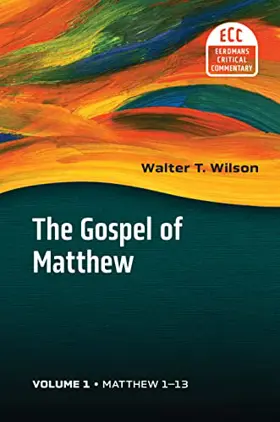

Matthew 1–13
in Eerdmans Critical Commentary
Pages
636
Publisher
Eerdmans
Published
11/29/2022
ISBN-13
9780802881816
What was the original purpose of the Gospel of Matthew? For whom was it written? In this magisterial two-volume commentary, Walter Wilson interprets Matthew as a catechetical work that expresses the ideological and institutional concerns of a faction of disaffected Jewish Jesus followers in the late first century CE. Wilson’s compelling thesis frames Matthew’s Gospel as not only a continuation of the biblical story but also as a didactic narrative intended to help shape the commitments and identity of a particular group that saw itself as a beleaguered, dissident minority. Thus, the text clarifies Jesus’s essential Jewish character as the “Son of David” while also portraying him in opposition to prominent religious leaders of his day—most notably the Pharisees—and open to cordial association with non-Jews.
Through meticulous engagement with the Greek text of the Gospel, as well as relevant primary sources and secondary literature, Wilson offers a wealth of insight into the first book of the New Testament for scholars, students, pastors, and interested laypersons. After an introduction exploring the background of the text, its genre and literary features, and its theological orientation, Wilson explicates each passage of the Gospel with thorough commentary on the intended message to first-century readers about topics like morality, liturgy, mission, group discipline, and eschatology. Readers interested in understanding what makes the Gospel of Matthew distinctive among the Synoptics will appreciate and benefit from Wilson’s deep contextualization of the text, informed by years of study of the New Testament and Christian origins.
Reviews
Overall, then, this is an impressive commentary on Matthew that reads the text that we have closely, and is by and large well-engaged with the secondary literature. Practically speaking, this is a 2 volume critical commentary – and that explains the price, and also the twenty plus pages of front matter, (identical) eighty pages of bibliography in each volume, and indices of Modern Authors, Subjects, and Ancient Sources (The latter including but by no means limited to the Bible!). One does wonder if it might have been manageable to squeeze the commentary into one volume (saving 100 pages at least), though it still would have been heft! The two 600+ pages volumes end up being nice to handle and read, with managable margins and a clear layout. Eerdmans have a reputation for producing beautiful sewn hardbacks – and this ECC is no exception.
[Full Review]
